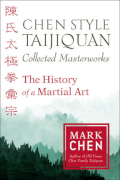History of Taijiquan
Chinese martial-arts histories are generally the subject of contentious argument, permeated with a liberal
mixture of hyperbole, romanticization, and apotheosis. Competing schools grope frantically into the remote past
for evidence of legendary or divine founders. Where no such evidence is available, it is often fabricated
whole-cloth; where it is available, its fabrication was likely the work of a previous generation. In either case,
it is then held up as indisputable proof that style X is more legitimate or older than style Y (because older is always
better in this calculus).
Sadly, the history of Taijiquan is not immune to such politically motivated fiddling. The elaborate
mythology constructed around its origin is far too abstruse to summarize in a short space, though the main fiction
-- centered on a semi-mythical figure named Zhang Sanfeng
( ) -- is
neatly disposed of by Stanley
Henning.
) -- is
neatly disposed of by Stanley
Henning.
Regarding the factual history of Taijiquan, our current state of scholarship supplies pitiably little information.
While it is clear that all of the major Taiji styles can trace their origins to Chen Village
( , Chen jia gou) in
Henan Province, this is certainly not the end of the story. The Chen Village (or "Chen family") style itself has
clear antecedents and close relations in several other systems, most notably various forms of Shaolin long boxing,
and, in terms of conceptual foundations, the Chang style of boxing
(
, Chen jia gou) in
Henan Province, this is certainly not the end of the story. The Chen Village (or "Chen family") style itself has
clear antecedents and close relations in several other systems, most notably various forms of Shaolin long boxing,
and, in terms of conceptual foundations, the Chang style of boxing
( , Chang shi wu ji)
that was documented by Qing dynasty scholar, Chang Naizhou
(
, Chang shi wu ji)
that was documented by Qing dynasty scholar, Chang Naizhou
( , 1724-1783?).
1
This apparently wide circulation of Taijiquan concepts at very early dates leads Douglas Wile to observe:
, 1724-1783?).
1
This apparently wide circulation of Taijiquan concepts at very early dates leads Douglas Wile to observe:
The existence of t'ai-chi language and theory in the body of a radically different art means that we
must rethink the evolution of t'ai-chi chüan in terms of diffusion rather than transmission.
2
Wile is undoubtedly correct. Many of the principles that Taijiquan practitioners are inclined to covet are not,
in fact, proprietary to Taiji. During the period of Taiji's early evolution, these ideas were being discussed and
implemented in at least one system (namely, Chang style boxing) that is clearly distinct from any known Taiji
style.
Having acknowledged that further discussion of ultimate origins must await discovery of fresh historical
sources, we can take up the vastly more tractable question of Taijiquan's descent following its established presence
in Chen Village.
There are two main branches of Chen style Taijiquan
( , Chen shi taijiquan),
that are still practiced today. The first is the Old Frame
(
, Chen shi taijiquan),
that are still practiced today. The first is the Old Frame
( , lao jia), which was
systematized by 14th-generation master Chen Changxing
(
, lao jia), which was
systematized by 14th-generation master Chen Changxing
( , 1771-1853) and descends
mainly from the 18th-generation master, Chen Zhaopi
(
, 1771-1853) and descends
mainly from the 18th-generation master, Chen Zhaopi
( , 1893-1972). The second
is the New Frame (
, 1893-1972). The second
is the New Frame ( , xin jia),
which was created by the 17th-generation master, Chen Fake
(
, xin jia),
which was created by the 17th-generation master, Chen Fake
( ,
1887-1957), and mostly propagated by his third son, Chen Zhaokui
(
,
1887-1957), and mostly propagated by his third son, Chen Zhaokui
( , 1928-1981).
Today's leading, 19th-generation exponents all apprenticed under Zhaopi and Zhaokui.
, 1928-1981).
Today's leading, 19th-generation exponents all apprenticed under Zhaopi and Zhaokui.
Important 19th-generation successors of both the old and new frames include grandmasters Chen
Xiaowang ( ),
Wang Xi'an (
),
Wang Xi'an ( ), Chen Zhenglei
(
), Chen Zhenglei
( ),
Zhu Tiancai (
),
Zhu Tiancai ( ), and Chen Qingzhou
(
), and Chen Qingzhou
( , 1934-2015).
, 1934-2015).
Chen Qingzhou was an Old Frame specialist, and disciple of Chen Zhaopi. He named his method "respect the
ancients" ( , zun gu) because it
endeavors to propagate an unaltered curriculum, exactly as handed down by Zhaopi.
, zun gu) because it
endeavors to propagate an unaltered curriculum, exactly as handed down by Zhaopi.
Chen Qingzhou
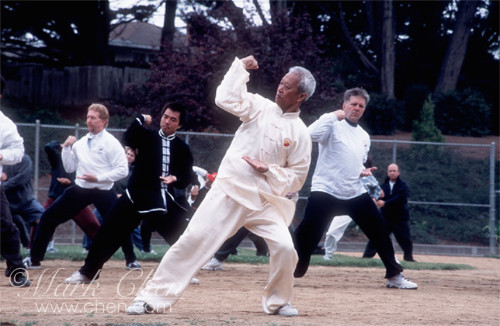 |
18th-generation master Feng Zhiqiang
( , 1928-2012) was a direct disciple
of Chen Fake
in Beijing, and developed the Hun Yuan (
, 1928-2012) was a direct disciple
of Chen Fake
in Beijing, and developed the Hun Yuan ( )
style of Taijiquan, based on New Frame Chen style. Hun Yuan Taiji incorporates elements of
Xingyiquan (
)
style of Taijiquan, based on New Frame Chen style. Hun Yuan Taiji incorporates elements of
Xingyiquan ( ) and Hun Yuan
qi gong. Feng's disciple, master Chen Xiang
(
) and Hun Yuan
qi gong. Feng's disciple, master Chen Xiang
( ), now carries on this lineage.
), now carries on this lineage.
Aside from the old and new frames of Chen Taiji, there are also practitioners of the Small Frame
( , xiao jia) and its variants,
which originate in Zhao Bao Village
(
, xiao jia) and its variants,
which originate in Zhao Bao Village
( ),
near Chen Village. This style is rarely seen outside of China.
),
near Chen Village. This style is rarely seen outside of China.
The first outsider who was permitted to learn the Chen Village art was a laborer named
Yang Luchan ( , 1799-1872). Yang
apprenticed
under Chen Village's 14th-generation master, Chen Changxing, before returning to his native Guang Ping City
(
, 1799-1872). Yang
apprenticed
under Chen Village's 14th-generation master, Chen Changxing, before returning to his native Guang Ping City
( ). During his time there,
and later in Beijing (where he was appointed instructor to the imperial banner battalions), he developed what is now
known as the Yang style of Taijiquan
(
). During his time there,
and later in Beijing (where he was appointed instructor to the imperial banner battalions), he developed what is now
known as the Yang style of Taijiquan
( , Yang shi taijiquan). This
style was later greatly popularized by his grandson, Yang Chengfu
(
, Yang shi taijiquan). This
style was later greatly popularized by his grandson, Yang Chengfu
( , 1883–1936) whose most well-known
student was Zheng Manqing (
, 1883–1936) whose most well-known
student was Zheng Manqing ( ,
1902-1975).
,
1902-1975).
Yang Chengfu
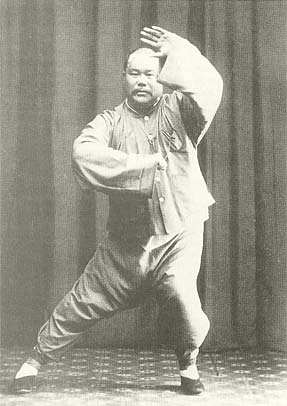 |
Among Yang Luchan's students in Guang Ping City was Wu Yuxiang
( , 1812–1880), who later combined
Yang Luchan's form with the Small Frame of Chen style to create the Wu (or "Small Wu") style of Taijiquan
(
, 1812–1880), who later combined
Yang Luchan's form with the Small Frame of Chen style to create the Wu (or "Small Wu") style of Taijiquan
( ,
Wu shi taijiquan). This employs high stances and small movements. Variants of this style include the
Li (
,
Wu shi taijiquan). This employs high stances and small movements. Variants of this style include the
Li ( ) and Hao
(
) and Hao
( ) styles.
) styles.
Sun style Taijiquan ( ,
Sun shi taijiquan) was developed by Sun Lutang
(
,
Sun shi taijiquan) was developed by Sun Lutang
( , 1860-1933) and is a re-synthesis
of the Hao and Yang styles, also incorporating certain elements of Xingyiquan and Baguazhang.
, 1860-1933) and is a re-synthesis
of the Hao and Yang styles, also incorporating certain elements of Xingyiquan and Baguazhang.
Sun Lutang
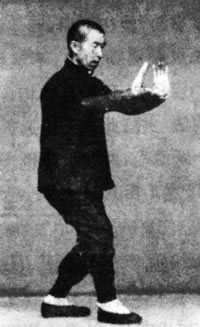 |
Wu (or "Big Wu") style Taijiquan ( ,
Wu shi taijiquan) was developed by Wu Jianquan
(
,
Wu shi taijiquan) was developed by Wu Jianquan
( , 1870–1942), whose father and
teacher, Wu Quanyou (
, 1870–1942), whose father and
teacher, Wu Quanyou ( , 1834–1902),
was a student of Yang Luchan. This style retains a clear similarity to Yang style.
, 1834–1902),
was a student of Yang Luchan. This style retains a clear similarity to Yang style.
Wu Jianquan
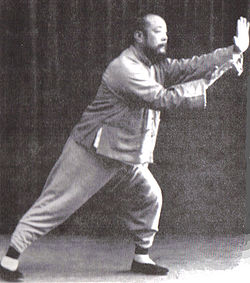 |
1. [See: Marnix Wells, Scholar Boxer: Chang Naizhou's Theory of Internal Martial Arts and the
Evolution of Taijiquan (Berkeley: Blue Snake Books, 2005).]
↩
2. [Douglas Wile, T'ai Chi's Ancestors (New York: Sweet Ch'i Press, 1999) 71.]
↩
 )
) ,
, ,
, ,
, ,
, ,
, ,
, ,
, ,
, ,
, ,
, ),
), ),
), ),
), ),
), ,
, , zun gu)
, zun gu)
 ,
, )
) )
) ),
), ,
, ),
), ,
, ).
). ,
, ,
, ,
,
 ,
, ,
,  )
) )
) ,
, ,
,
 ,
,
 ,
, ,
,







